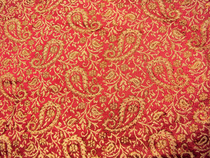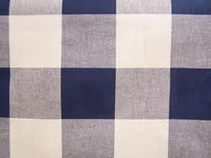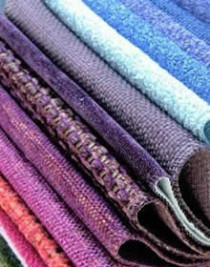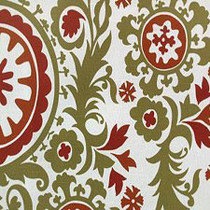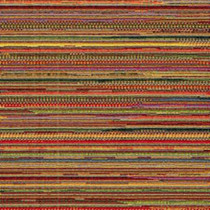
Brocade
A term describing both a weave and a fabric type -- a rich, heavy, jacquard woven fabric. Relief patterns, typically in a floral or paisley motif, emphasized by contrasting colors and surfaces produced by the filter thread. True brocades have “floating” yarns on the reverse side, while fine brocades often have threads of real gold or silver.
Chevron
Very similar to a flame stitch, but found mostly in multi-purpose weight prints. The chevron is not an embroidered flame stitch, but is composed of zigzag lines that are printed onto the fabric. May be found in an array of colors and printed on different fabric grounds, ranging from cotton, linen, rayon and polyester.
Damask
A classic fabric that has existed unchanged for hundreds of years. The original figured designs of Pomegranates and stylized floral were first produced in Europe
in the late 15th century. Woven on Jacquard loom, and is when different weaves are used for the pattern and background and woven in one color and reversible. The pattern is made visible by the effect
of light striking contrasting satin and mattes urface areas. Originally made of silk, damasks are now made of linen, cotton, rayon, wool or a combination of any
two.
Paisley
From the Scottish town of Paisley, the 19th century center for the production of Indian-style shawls. The Motif’s source is thought to have been adapted from
European illustrations of the date palm sent to the East in herbal glossaries. In India the motif is known as “buta", meaning flower, which was incorporated into textiles, carvings and tiles. Paisley
motifs have been described as a pine cone, mango, pear and teardrop.
Silk
The Chinese discovered silk cocoons 4,500 years ago. They domesticated the silkworm and maintained a monopoly on silk production for centuries. Silk takes dye
superbly and produces iridescent colors. The texture may vary from supple to crisp, but slubs are often evident. Natural light can often discolor silk.
Suzani
A heavy and soft upholstery weight textile in a jacquard weave. Surface appears puffy or cushioned. The pattern may vary in size or shape or may have multiple color ways. Very
similar to a tribal pattern shown in very bright and bold colors. May also be printed onto a cotton or polyester fabric, allowing for it to be used as a multi-purpose fabric.
Tapestry
A symbol of wealth and nobility during the middle ages. The art of tapestry was revived in the 19th century. Often called the “mirror of civilization” because so
many tapestries representing scenes of everyday life. Jacquard loons are used today with the multiple sets of warp and filling yarns used to create the design or pattern. A very durable fabric for
upholstery, tapestry is most effective on tight cushions and straight skirts.
Ticking
Originally hand-woven of linen as covering for feather mattresse, the characteristic herringbone weave was intended to keep feathers in and ticks out. It is a
closely woven cotton in a twill or satin weave, usually with woven (sometimes printed) stripes. Tickings are popular today for upholstery, accent fabrics and as wallpaper patterns.
Tweed
A category of wool fabrics made from worsted yarns, usually woven of two colors in a plain, twill or herringbone weave to create some type of checked, plaid or
multi-speck pattern. Originally made by hand in the homes of the country people near the Tweed River which separated England and Scotland.
Woven
Woven fabrics are produced from virtually all types of textile fibers and threads. The fabric is produced by weaving the perpendicular threads--the warp and weft. The fabric is
very durable and is most commonly found in upholstery weight goods. Depending on the sector of the textile industry producing the fabric and the principal fiber composition, they may be classified as
cotton, linen, wool, polyester, olefin or rayon.
Velvet
Popular since the 16th century, velvet is a pile fabric with short, closely-woven cut pile and a rich, soft texture. Velvets have a nap, or directional quality and require
consistent direction in cutting and frame applications. They are made of cotton, linen, synthetic fibers or silk and may be finished to become crush-resistant and water repellent.

